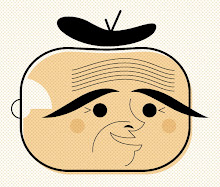Wednesday, December 16, 2009
About Me

- Name: Oscar Grillo
- Location: London, United Kingdom
I've been working professionally as an artist since 1960. My avatar has been drawn by Matt Cruickshank.
I put together this blog in order to show
my animation and "commercial" art...
http://okgrillo.blogspot.com/
organised by my good friend Rubén González
remains online for my more personal work.
10 Comments:
A pesar de sus períodos, su pañuelo siempre fue rojo.
Rojo período.
En fin.
Masterful.
You captured the intensity.
Do you have a favourite Picasso period? I find the work just after Cubism very pleasurable on the eye (the still life compositions and collage particularly) but then I also love the vibrancy of his colour after his move to the south of France.
It's difficult as I like virtually everything he did. I think I like what he represents more.
I love every period of Picasso but I have a particular affection for the women portraits of the thirties and the drawings from the fifties to the seventies
It's incredible isn't it- defining his output by decades.
Would you concur with Picasso being a "mans" artist. I expect it's unsettling for some women to see how he could be both beautiful and destructive with his female subjects- loving them to begin with before chewing them up.
But I don't know, I'm not a woman.
Yet.
"la vida"
Escuché a una miope historiadora del arte -de esas que se pintan la boca de rojo excediendo los límites de los labios- decir en una de sus clases que los motivos del periodo azul fueron principalmente económicos. Me gustaría saber si realmente eran más baratos los óleos azules; sea como sea es una gilada esa teoría.
Los azules estuvieron siempre entre los colores mas caros del espectro (venian del lapis lazuli que traian de Afghanistan, por ejemplo) Una demostracion de riqueza entre los nobles italianos era la cantidad de azul que le exigian a los pintores poner en el trabajo para que la obra fuese mas cara y pudiera demostrar munificencia en las iglesia a las cuales le regalaban los cuadros.
Confirmacion encontrada en el internet:
"Was Oil Paint Expensive to Make?
Sometimes, Yes. The oil itself was not expensive but some pigments were. The three costliest pigments used in Renaissance art were gold, ultramarine (from the semi-precious Asian stone Lapis Lazuli) and red Lac (from India). In fact these three colours were so costly that typically their use would be stipulated in the painting contract issued for the commission in question."
Me confirma una sospecha que tenía; creo que los historiadores del arte suelen decir pelotudeces como esa.
Quizá por eso "Nel blu dipinto di blu" sea una canción tan cara!
Post a Comment
<< Home